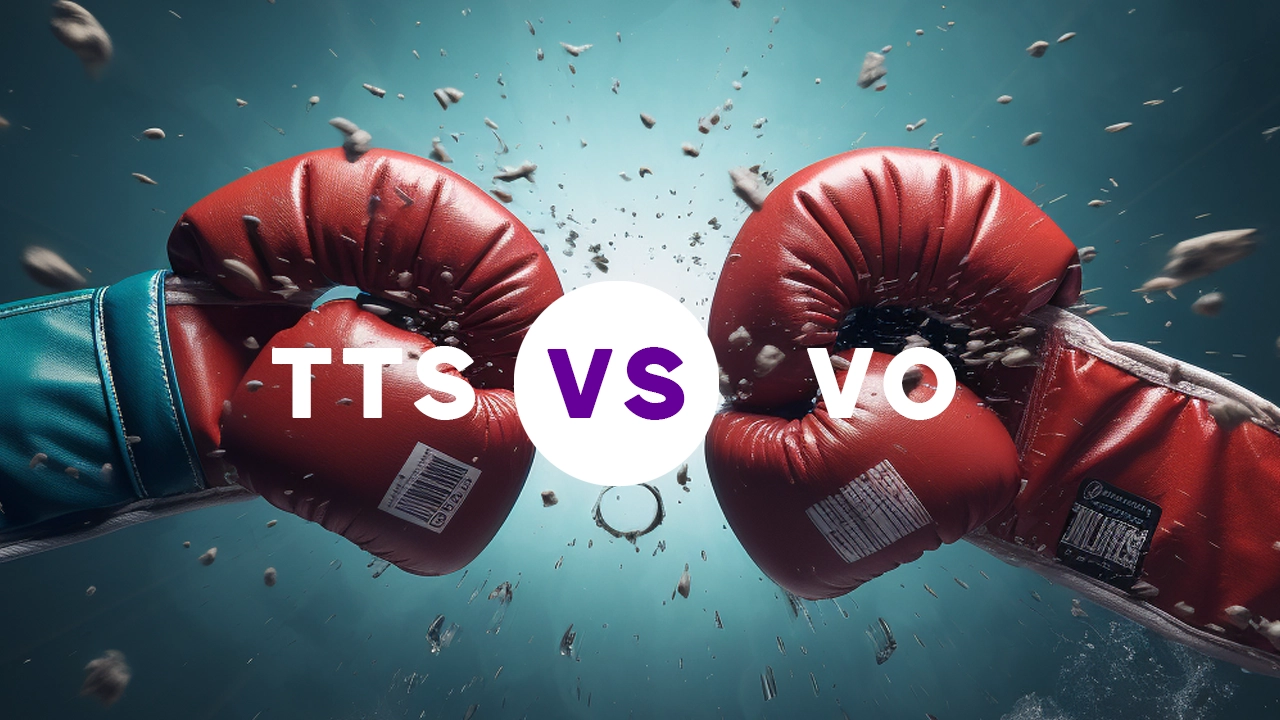Text to Speech vs Voice Overs. What’s the Difference?

Almost everyone knows of, heard of, or have used some sort of text to speech technology. TTS is almost a household name. As of late, AI voice overs have begun to take the video world by storm and sometimes the two are confused. Worry not, let’s dig into text to speech vs voice overs. Are they they the same? Are they different?
Text to Speech (TTS) and Voice Overs (VO) both have their unique strengths and applications, making them indispensable tools in various industries. Let’s dive into the nuances of TTS vs VO, exploring their advantages, limitations, and the contexts in which they excel.
The short answer
Text to speech is a technology. This relies on OCR and speech synthesis by machines scanning text and then reading it aloud. Voice overs on the other hand employs text to speech technology to create AI voice overs.
First, Text to Speech: The Rise of Synthetic Voices
Text to Speech technology, at its core, converts written text into spoken words using synthetic voices. This technology has seen remarkable advancements in recent years, thanks to the integration of artificial intelligence and deep learning.
Advantages of Text to Speech:
- Cost-Effective and Efficient: TTS is significantly more cost-effective than hiring voice actors for VO. It’s especially useful for projects with tight budgets or those requiring quick turnarounds.
- Consistency: TTS provides consistent voice quality and style, which is crucial for projects like e-learning modules or public announcements, where consistency in tone and articulation is key.
- Language and Accent Diversity: Modern TTS systems offer a wide range of languages and accents, making them ideal for global applications.
Limitations of Text to Speech:
- Emotional Range: Despite advancements, TTS still lags behind human voice actors in conveying emotions and subtleties in tone.
- Customization: While TTS offers various voices, the customization of these voices to fit specific characters or moods is limited compared to VO.
Top 5 Use Cases for Text to Speech
- Accessibility for Visually Impaired and Dyslexic Users: TTS is a powerful tool for enhancing accessibility in digital content. It assists visually impaired users by reading out text from websites, eBooks, and digital documents. This technology also supports individuals with dyslexia and other reading difficulties, allowing them to consume written content more easily by listening to it.
- E-Learning and Online Courses: TTS is extensively used in the educational sector, especially in e-learning platforms and online courses. It enables the creation of audio versions of textbooks, study materials, and course content, making learning more flexible and accessible. TTS can cater to different learning styles and helps in providing education in regions with low literacy rates.
- Automated Customer Service and Interactive Voice Response (IVR) Systems: Many businesses employ TTS for their automated customer service systems and IVR. TTS can provide customers with clear, concise information in response to their queries. This application is particularly useful in call centers, help desks, and automated phone systems, where it can guide users through menus and provide information without the need for a human operator.
- Public Announcements and Transportation Alerts: TTS technology is widely used in public transportation systems for announcements and alerts. It provides passengers with real-time information about schedules, delays, and safety instructions. This use of TTS ensures consistent and clear communication in train stations, airports, and bus terminals.
- Voice Assistants and Smart Devices: TTS is a key component in voice assistants and smart home devices, enabling them to communicate with users. It allows these devices to read out news updates, weather forecasts, emails, and other information. TTS enhances the usability and interactivity of voice assistants, making them more user-friendly and efficient in managing tasks and providing information.
Voice Overs: The Human Touch in Audio
Voice Overs, performed by human actors, have been the traditional method of adding narration to videos, commercials, and other audio-visual content. The human element in VO brings a level of authenticity and emotional depth that TTS currently cannot match.
Advantages of Voice Overs:
- Emotional Depth and Nuance: Human voice actors excel in conveying a wide range of emotions, making VO ideal for storytelling, commercials, and any content that requires emotional engagement.
- Customization and Versatility: Voice actors can modify their tone, pace, and style to suit different characters and moods, offering a level of customization that TTS cannot achieve.
- Naturalness: The natural flow and idiosyncrasies of human speech make VO more relatable and engaging to audiences.
Limitations of Voice Overs:
- Cost and Time: Hiring professional voice actors can be expensive and time-consuming, especially for large projects or those requiring multiple languages.
- Consistency Issues: Maintaining consistency in voice quality and style across different sessions can be challenging with VO.
Top Use Cases for Voice Overs
Voice Over (VO) talent is crucial in numerous industries, adding a human touch to various forms of media and communication. Here are five significant use cases for voice overs:
- Advertising and Commercials: Voice overs are essential in the advertising industry. A skilled voice actor can convey a brand’s message effectively, evoking the desired emotional response from the audience. Whether it’s for television, radio, online ads, or podcasts, the right voice over can significantly impact the success of a marketing campaign.
- Film and Animation Dubbing: Voice overs play a pivotal role in dubbing films and animation into different languages. They allow audiences around the world to enjoy media in their native language while preserving the original emotions and nuances of the characters. This is not only important for feature films but also for animated series and video games.
- Audiobooks and Storytelling: The audiobook industry relies heavily on voice over artists to bring stories to life. A narrator’s voice can add depth and personality to characters and engage listeners, making the experience more immersive. Voice overs in storytelling are also used in podcasts and radio dramas.
- Corporate Training and E-Learning Modules: Many companies use voice overs in their training and e-learning modules. A professional voice can make instructional content more engaging and easier to understand. This is particularly useful for training videos, online courses, and interactive learning programs.
- Documentaries and Narration: Voice overs are critical in documentaries and non-fiction video content, providing narration that guides the viewer through the story. A narrator’s voice can add context, explain complex concepts, and maintain the viewer’s interest throughout the documentary.
Text to Speech vs Voice Over Comparison Table
| Feature | Text to Speech | Voice Overs |
|---|---|---|
| Providers | Plenty of providers | Limited but evolving |
| Emotion & tone | Limited | Wide range |
| Flexibility | Non editable | Can edit voices |
| Cost | Lower | Higher |
| Use cases | Personal and professional | Mostly professional |
| Availability | Across all devices and even browser extensions | Mostly for laptops with some apps for smart phones |
The Best of Both Worlds: Blending TTS and VO
In many scenarios, the optimal solution lies in combining TTS and VO. For instance, TTS can be used for the bulk of an e-learning course, with human VO employed for key sections that require emotional depth. This hybrid approach offers both cost-effectiveness and emotional engagement.
Applications in Different Industries
- E-Learning: TTS is widely used for its efficiency and cost-effectiveness. However, for modules requiring storytelling or emotional engagement, VO is preferred.
- Advertising: VO remains the go-to choice for commercials due to its emotional impact, although TTS is gaining ground in digital advertising.
- Audiobooks: While TTS is used for some audiobooks, VO is preferred for fiction and narrative-driven books where performance is key.
- Accessibility: TTS plays a crucial role in making content accessible to visually impaired users and those with reading difficulties.
The Future of TTS and VO
The future of digital audio is incredibly exciting, with both TTS and VO continuing to evolve. AI-driven TTS is becoming more natural and expressive, narrowing the gap with human VO. Conversely, VO artists are leveraging technology to enhance their performances and efficiency.
Emerging Trends:
- AI-Enhanced Voice Acting: Voice actors are using AI tools for voice modulation and to create different versions of their performances efficiently.
- Deepfake Audio: Advanced TTS systems can mimic specific voices, raising ethical questions and potential uses in personalized advertising and entertainment.
- Real-Time Translation: TTS combined with real-time translation technology is breaking language barriers in international communications and media.
Text to Speech and Voice Overs each have their unique strengths and play vital roles in the digital audio landscape. While TTS offers efficiency, cost-effectiveness, and consistency, VO provides emotional depth, customization, and naturalness. The choice between TTS and VO depends on the project’s requirements, budget, and the emotional depth required. As technology advances, the line between synthetic and human voices is blurring, leading to a future where the best attributes of both converge to create more engaging and accessible audio content.
The ongoing evolution in this field promises to bring more innovations, enhancing the way we experience and interact with digital audio. As we look to the future, it’s clear that both Text to Speech and Voice Overs will continue to play critical roles, individually and in tandem, shaping the auditory landscape of our digital world.










